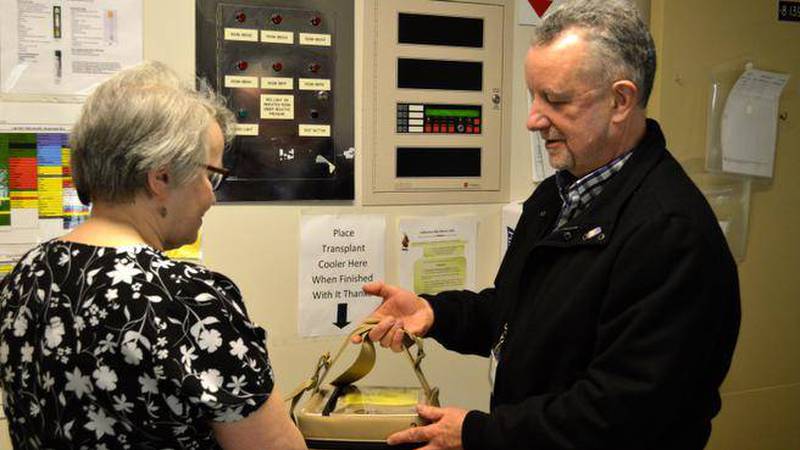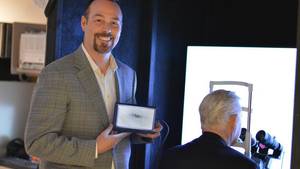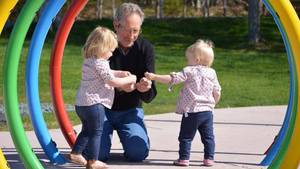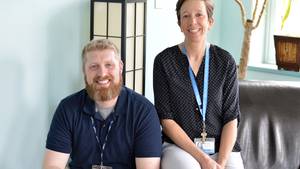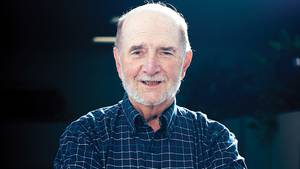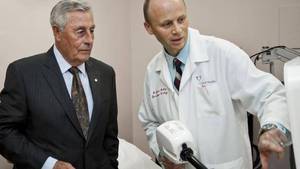Having spent a lifetime helping people, Neil Fraser didn’t want to stop in retirement. A 35-year career with the RCMP prepared him for the profound experience he’s having now, travelling the world retrieving and transporting life-saving stem cells to QEII patients with blood disorders.
“It’s very, very rewarding,” says Neil, who joined the QEII’s Blood and Marrow Transplant (BMT) volunteer courier program in April 2013. Since then, Neil has travelled across North America and Europe retrieving cells for patients in Halifax who have blood cancers, such as leukemia, lymphoma and multiple myeloma. “Not many people get an opportunity to help people in such a meaningful way.”
Neil vividly remembers a moving experience he had when he met a patient who would be receiving stem cells, similar to the cells he has delivered on many occasions to the medical team at the QEII. “This is just like Christmas,” the patient told him.
“Meeting that patient really drove it home how important this is,” says Neil.
While the BMT program, which serves patients across Atlantic Canada, started more than 20 years ago, the volunteer courier program began in 2013. Previously, the program relied on its two coordinators, both registered nurses, to transport the stem cells. But with increased patient care demands for the program, and the amount of time coordinators were away from the office, Shelley Brown, manager of the QEII’s BMT program, knew she had to do things differently.
“By implementing the volunteer program, money is not only being saved, but time with patients has increased,” says Shelley. She estimates 1,300 additional patient-care hours are now available with both coordinators in the office full time.
“Initially the BMT program was designed to serve about 20 patients each year needing stem cell transplants; the program now performs approximately 110 transplants per year. With advances in patient care technologies and medications, this increase is expected to continue,” she says.
Knowing it was necessary to make a change, Shelley started by surveying BMT programs across Canada and found that each was doing it slightly different. Some hospitals used paid staff to transport cells while others worked with volunteer societies. She opted to go with a volunteer-based in-house program with stringent recruitment criteria and a thorough training component.
Shelley engaged Volunteer Services to explore options and to participate in the ongoing screening and recruitment of BMT couriers. Providing and transporting stem cells to patients is strictly regulated by Health Canada and with stem cell registries available around the world, Shelley knew that competency in international travel would be a must for volunteers.
The 10 volunteers in the program are all retired professionals, including RCMP officers, nurses, teachers, and an IT project manager. A two-year commitment to the program is required and on average, each volunteer makes two or three trips per year, each trip lasting two or three days.
Neil is aware at all times that he is delivering a life-saving medical product. “It is not a vacation,” he says. His international work with the RCMP prepared him for thinking quickly on his feet and negotiating busy airports, different languages and strict airport security. For patient confidentiality, Neil doesn’t talk about the specific hospitals or blood clinics he visits.
“The retrieval destinations must remain confidential,” says Shelley.
When Neil hand delivers the stem cells he has carried, sometimes halfway around the world, to a BMT nurse waiting at the QEII’s transplant unit, he knows he has made a once-in-a-lifetime trip.
“The volunteer couriers understand the gravity of what they are doing,” says Shelley. “They see it as a mission, a mission to save someone’s life.”
While the BMT program is not currently recruiting, the QEII is always looking for volunteers who contribute to the health care of patients and their families. Please contact 902 473 2457 or visit www.cdha.nshealth.ca/giving-volunteering.

